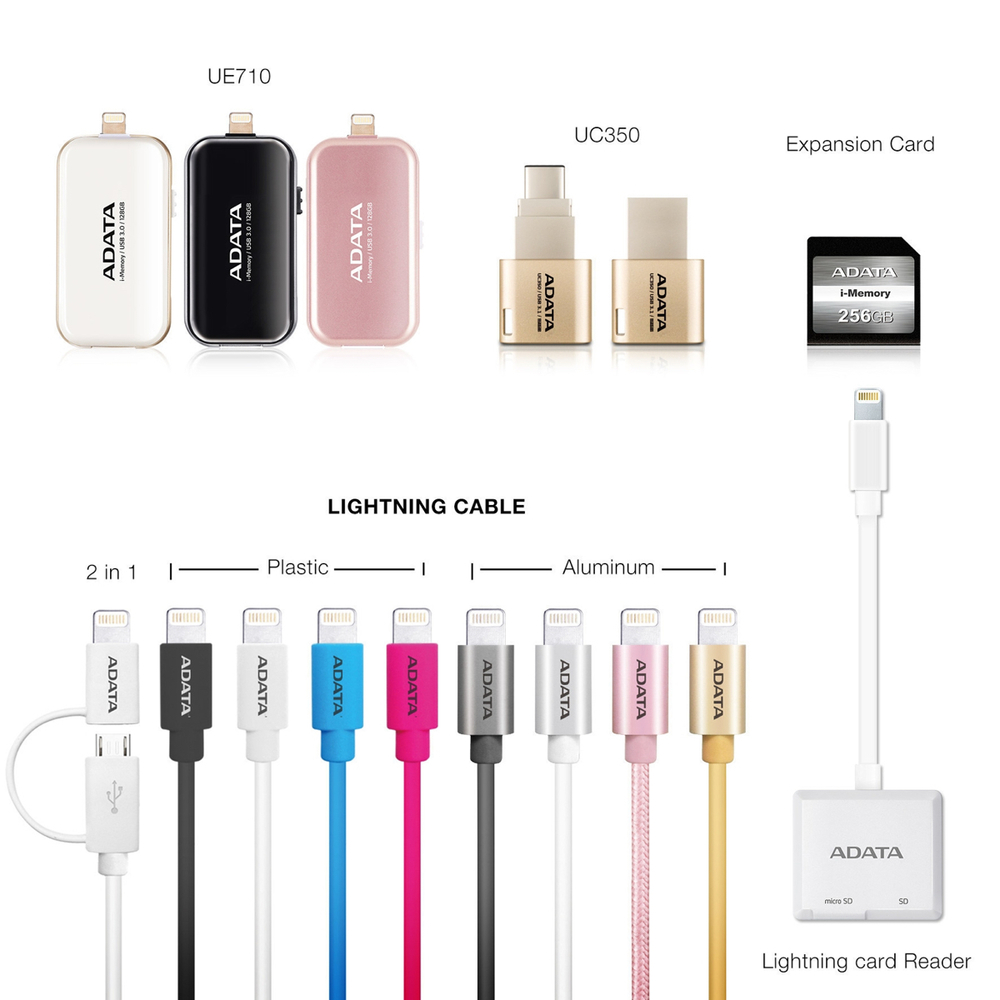ADATA Technology has launched its Apple Series in North America. The accessories are designed specifically for iOS and OS X devices, including the iPhone, iPad, iPod, and Mac.
The initial five products are: the Lightning card reader, i-Memory flash drive UE710, i-Memory storage expansion card, USB type-C OTG flash drive, and Lightning cables. Fully Apple MFi certified, the ADATA Lightning card reader gives users convenient interconnectivity, as it’s the first product of its type with two-way data transfer (read and write), enabling users to freely move content to, from or among Apple, Android and digital camera devices, says Robert Chen, managing director of North America at ADATA. Apple’s MFi Program (“Made for iPhone/iPod/iPad”) is a licensing program for developers of hardware and software peripherals that work with Apple’s iPod, iPad and iPhone.
It’s also the first reader to combine SD and microSD on one unit. The Lightning Card reader comes bundled with a free interface app for content management and media playback. In addition to its Apple compatibility, it supports other multimedia formats, including RAW, MKV, WMV, AVI, RMVB, and more. The Lightning Card Reader costs $49.99 — or $54.99 with a 32GB microSD card.

Fully Apple MFi certified, the ADATA i-Memory UE710 flash drive features a dual connector design, combining Apple Lightning and USB 3.0. It offers data transfer and backup between mobile iOS devices as well as Windows PC. It supports Ultra HD 4K video playback, Apple AirPlay audio and video content with Apple TV compatibility. Additionally, the i-Memory is the first flash drive to feature Live Photos back up, according to Chen. The ADATA i-Memory UE710 comes in 32GB, 64GB, and 128GB versions for $69.99, $89.99, and $129.99, respectively.
The device comes with a free i-Memory app, which offers user-friendly content management features. It supports most video formats (nearly 40) and high-quality audio playback. It’s available in black, white and rose gold with 32GB, 64GB, and 128GB capacities.
Designed exclusively for MacBook Air 13-inch storage expansion, the ADATA i-Memory card is a light SSD-like storage expansion on the market that delivers read/write speeds of 95MB per second read and 60MB per second write. Its plug-and-play design allows users to back up or share high definition photos and videos of up to 256GB. With built-in industrial MLC flash making it more durable, it also can be used as an extra SSD. The i-Memory Storage Expansion Card is water, dust and shock resistant. It comes in 64GB, 128GB, and 256GB models for $34.99, $64.99, and $154.99.
The ADATA UC350 dual-connector on-the-go flash drive incorporates a USB type-C interface with reversible plug, which minimizes the need to check connector alignment. The device can transform from a Type-A USB 3.1 to a Type-C USB 3.1 connector, allowing users to enjoy data exchange (files, photos, videos, etc.) between iOS, Android, MacBook, and Windows PC at fast (100MB per second read and 30MB per second write) speeds. The ADATA UC350 supports USB 3.1 Generation 1 protocols, which exceed USB 3.0 performance. It features cap-less design, metal housing and is available in sizes up to 64GB capacity.
Fully Apple MFi certified, the approximately 40-inch long ADATA Lightning cables provide charging and cross-device data syncing. Included in the selection is a 2-in-1 version that comes with Lightning and MicroUSB ports that are compatible with both Apple and Android devices. Each cable supports a 2.4A current, providing rapid device charging to save time and increase efficiency. Cables are insulated to eliminate electromagnetic interference. They’re available in multiple colors. Lighting cables cost $12.99 for the two-in-one model, $9.99 for the aluminum version, and $7.99 for the plastic edition.
Encrypt the files you send with Encrypto from MacPaw



